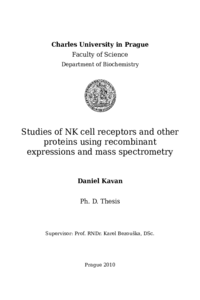Studies of NK cell receptors and other proteins using recombinant expressions and mass spectrometry
Studium NK receptorů a jiných proteinů metodami rekombinantní exprese a hmotnostní spektrometrie
rigorózní práce (UZNÁNO)

Zobrazit/
Trvalý odkaz
http://hdl.handle.net/20.500.11956/31971Identifikátory
SIS: 98083
Kolekce
- Kvalifikační práce [19612]
Autor
Fakulta / součást
Přírodovědecká fakulta
Obor
Biochemie
Katedra / ústav / klinika
Katedra biochemie
Datum obhajoby
13. 9. 2010
Nakladatel
Univerzita Karlova, Přírodovědecká fakultaJazyk
Angličtina
Známka
Uznáno
Receptor CD69 je považován za marker aktivovaných lymfocytů a je exprimován na všech místech aktivní imunologické odpov diě . Fyziologicky se vyskytuje jako disulfidicky vázaný homodimer, ovšem z modelu je patrné, že k dimerizaci krom disulfidického m stku značnou mírou p ispívá také kontaktě ů ř Q93 jedné a D88 spolu s E87 na druhé podjednotce a ješt výrazn jiě ě R134 jedné a A136 a Y135 druhé. Na základ tohoto pozorování byly Q93, R134 nebo oboje mutoványě na alaniny a následn ukázáno, že jako monomer se chovala jen dvojnásobn zmutovanáě ě forma. Tato skutečnost m la také významný vliv na vazbu sacharidových ligand , neboě ů ť monomerní forma vykazovala výrazn nižší afinitu ke GlcNAcu (ě Kd ádov 10ř ě -5 M), než forma dimerní (Kd ádov 10ř ě -6 M) nebo dokonce delší kovalentn dimerní konstruktyě (Kd ář dov 10ě -7 M). Oproti pozorovanému kratšímu času eluce z gelov filtrační kolonyě po vysycení receptoru ligandem (GlcNAc), který by mohl naznačovat zm nu struktury,ě však experimenty v analytické ultracentrifuze neukázaly žádnou zm nu sedimentačníhoě koeficientu, podobn ani porovnání nam ených HSQC NMR spekter p ed a po vysyceníě ěř ř ligandem neodhalily žádné výrazné zm ny.ě Vodíko-deuteriová vým na je chemický d j, p i kterém je kovalentně ě ř ě vázaný atom vodíku vym n n za deuterium, nebo...
CD69 is considered as the marker receptor of activated lymphocytes and is expressed at sites of active immune response. Physiologically it appears in the form of covalently bound homodimer, however after examining its three- dimensional structure we suggested Q93 on one subunit and D88 with E87 on the other one to participate on the inter-subunit interactions. Even more profound intertwining was observed in case of R134 of one subunit with A136 and Y135 on the other one. Therefore Q93, R134 or both were mutated into alanines and showed the monomeric form just in case of double-mutant. This fact influenced significantly also the binding of ligands. While the Kd values for binding of GlcNAc was approximately 10-5 M in case of monomeric form, in case of dimeric form it was 10 times lower and even 100 times lower in case of the longest covalently bound dimers. Although the gel filtration retention time decrease was observed, which could indicate a change in molecular fold, the value of experimentally determined sedimentation coefficient was identical. Moreover neither the comparison of HSQC NMR spectra before and after ligand saturation revealed any significant shifts. Hydrogen deuterium exchange is a chemical process in which a covalently bonded hydrogen atom is replaced by deuterium or vice versa. As...
